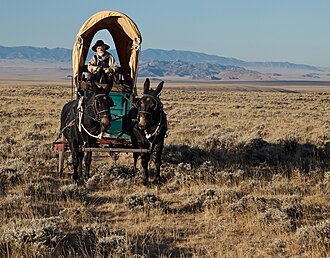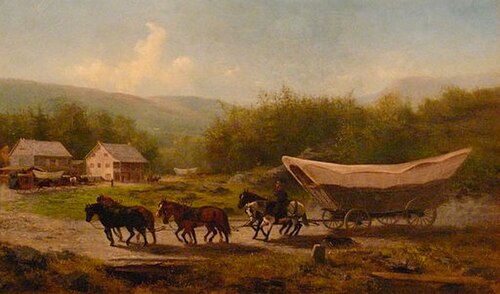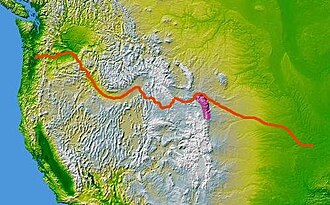
The Oregon Trail refers to an approximately 2,000-mile land route stretching from Independence, Missouri to Oregon City, Oregon. It became a crucial pathway for pioneers and served as a major gateway for westward migration in the United States. The popularity of this U.S. migration route had a significant role in the settlement and population growth of America's Pacific Northwest. The trail also became a commonly used route during the California Gold Rush, beginning in 1848.
From start to finish, the Oregon Trail passed through six present-day states: Missouri, Kansas, Nebraska, Wyoming, Idaho, and Oregon. Researchers seeking individuals who traveled the trail may need to explore records in each of these locations.
These MyHeritage collections may include Oregon Trail families:
- Portrait and Biographical Record of Western Oregon on MyHeritage
- Oregon Newspapers, 1867-2009 on MyHeritage
- Oregon, Births and Christenings, 1868-1929 on MyHeritage
- Oregon, Marriages and Divorces, 1841-1964 on MyHeritage
- Idaho, Marriages, 1878-1898, 1903-1942 on MyHeritage
- Western United States, Marriage Index, 1838-2016 on MyHeritage
Research your ancestors on MyHeritage
Research your ancestors on MyHeritage
Historical contextHistorical context

While fur trappers, explorers, and missionaries traveled the route in the early 1800s, the Oregon Trail gained widespread use from emigrant parties beginning in 1841.[1] From the 1840s to the 1860s, it served as the main westward migration path in the United States. While paving the way for expansion, it also led to Native American conflicts along the way.
It was a long and tedious journey, taking about 4 to 6 months to complete; travelers would often go 12 to 15 miles a day.[2] That meant early mornings, significant preparations, and careful planning. Wagons were filled with supplies including food, tools, and weapons for protection. Pioneers frequently restocked along the way.
Risks along the Oregon Trail included severe weather, dangerous terrain, and widespread disease, especially for families and groups who stayed in close proximity. Cholera epidemics in the early 1850s were particularly devastating.[1]
It was common for pioneers who traveled the Oregon Trail to have a wagon. A specific type – the Conestoga wagon, named for a Pennsylvania river valley – became the most famous due to media portrayals. It was large in size, generally about 17 feet long and 11 feet tall, with plenty of space for hauling supplies, and it had a double cover to protect cargo from the weather.[3] However, most Oregon Trail pioneers had smaller and lighter wagons that were better suited for long-distance travel. Many of the travelers kept diaries, providing valuable firsthand accounts.[4] A computer game based on the Oregon Trail was developed in 1971 and it was distributed in schools across America.[5]
How to find genealogical records along the Oregon TrailHow to find genealogical records along the Oregon Trail

For genealogists and researchers seeking travelers of the Oregon Trail, the following resources are invaluable:
- Land Claims: The U.S. Bureau of Land Management (BLM) maintains a general database of land records and it includes Oregon Donation Land Claims. Many settlers received land under the Donation Land Claim Act of 1850. Search these records at the U.S. Department of Interior Bureau of Land Management database.
- Early Oregon Settlers Database: The State of Oregon maintains an Early Oregonians Database that is searchable by first and last name. It focuses on individuals who lived in Oregon prior to it becoming a state in 1860. The records include date of birth, place of birth, parents' names, date of death and place of death, when known. It encompasses all kinds of records from census data to vital statistics, and in many cases family groupings and relatives are listed.
- Topical Research Aids: The State of Oregon has published a series of research aids on specific types of records, including adoption, census, land, military, naturalization, hospital, probate, and vital records. These guides can be helpful to locate collections, including online databases, based on the county or name of interest.
- Emigrant Lists for the Oregon Trail: Oregon Pioneers has extensive historical resources to learn more about the Oregon Trail, links to maps, and it also has emigrant lists sorted by year. These begin with a "pre-1839" list of pioneers, sorted alphabetically by surname, and there are additional lists for ever year up until 1855.
- Paper Trail: This searchable collection from the Oregon-California Trails Association includes names, origins, year of journey, and additional information like sources to find original documents.
Additional resources can be found through websites like the Oregon Historical Society, the Oregon-California Trails Association, the National Oregon/California Trail Center in Idaho, and Oregon City's Genealogy Program.
See alsoSee also
Explore more about the Oregon TrailExplore more about the Oregon Trail
- Researching Oregon Trail Ancestors by Legacy Family Tree Webinars
- Travel Blog: The Oregon Trail by the National Park Service
- Blending Families at the End of the Oregon Trail by Oregon Trail Genealogy
- Forgeys on the Oregon Trail by AK's Genealogy Research
- How to Trace the Trails of Your Pioneer Ancestors by GenealogyBank
- Genealogy: There are ways to find ancestors who moved west by The Augusta Chronicle
References
- ↑ 1.0 1.1 Oregon Trail Chronology, End of the Oregon Trail, Historic Oregon City. HistoricOregonCity.org https://historicoregoncity.org/2019/04/03/oregon-trail-chronology/
- ↑ Traveling the Emigrant Trails: The Oregon Route. National Park Service. https://www.nps.gov/articles/000/traveling-emigrant-trails.htm
- ↑ Wagons on the Emigrant Trails. National Park Service.https://www.nps.gov/articles/000/wagons-on-the-trails.htm
- ↑ Oregon Trail Diaries. Oregon-California Trails Association. https://octa-trails.org/articles/oregon-trail-diaries/
- ↑ 50 years of The Oregon Trail: The hidden controversies of a video game that defined the US. The BBC.https://www.bbc.com/future/article/20241219-the-oregon-trail-how-a-50-year-old-video-game-defined-america

